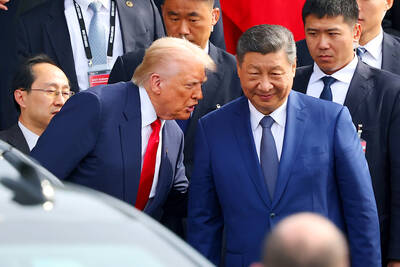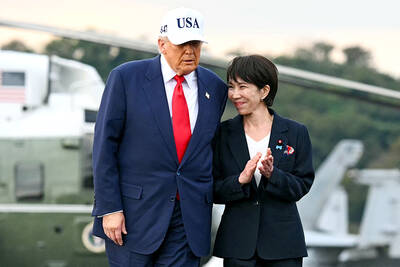The US military yesterday denounced the release of a video showing a soldier captured in Afghanistan, calling the images Taliban propaganda that violated international law.
The video shows the soldier in traditional Afghan dress, being prompted in English by his captors to call for US forces to be withdrawn from Afghanistan.
“The use of the soldier for propaganda purposes we view as against international law,” military spokesman Captain Jon Stock said, confirming that the man in the video was the missing soldier, whose name has not been released. “We are continuing to do whatever possible to recover the soldier safe and unharmed.”
The US military was distributing leaflets last week seeking the release of the soldier, missing since late last month.
Military spokeswoman Captain Elizabeth Matthias said it was the first case she was aware of in which a US service member was held captive by the enemy in Afghanistan, although there have been similar cases in Iraq.
The video has not appeared yet on Web sites regularly used by the Taliban or al-Qaeda.
In the video, portions of which were available on the Internet video sharing site YouTube, the soldier appeared with his head shaven and a slight beard, wearing traditional gray, loose-fitting Afghan shalwar kameez clothing.
He appears to be in good health and is shown drinking tea and eating bread and rice. When he speaks to the camera, a voice can occasionally be heard prompting him in English.
“Well, I am scared. I’m scared I won’t be able to go home. It is very unnerving to be a prisoner,” the soldier says. “I have my girlfriend who is hoping to marry. I have my grandma and grandpas. I have a very, very good family that I love back home in America.”
A voice off camera prompts: “Miss them.”
The soldier continues: “And I miss them every day that I’m gone. I miss them and I’m afraid that I might never see them again and that I’ll never be able to tell them that I love them again. I’ll never be able to hug them.”
At one point the voice prompts: “Any message to your people?”
“Yes. To my fellow Americans who have loved ones over here, who know what it’s like to miss them: You have the power to make our government bring them home,” the soldier says. “Please, please bring us home so that we can be back where we belong and not over here wasting our time and our lives and our precious life that we could be using back in our own country.”
Mawlavi Sangin, a senior Taliban commander in Paktika Province, the southeastern area where the soldier went missing, told reporters on Thursday his men were holding the soldier and would kill him if the military applied pressure to find him.
Some US leaflets dropped in the area showed a US soldier shaking hands with smiling Afghan children and read: “One of our American guests is missing. Return the guest to his home.”
But others were more aggressive, showing soldiers kicking in the doors of a house, with the words: “If you do not release the US soldier you will be hunted.”
Cases of US troops going missing have been rare during the wars in both Iraq and Afghanistan.
In Iraq, three soldiers were captured by insurgents after a firefight in 2007 in an area south of Baghdad known as the triangle of death. One was killed shortly after his capture, while the other two were found dead nearly two months later.
In 2005, Navy Seal Marcus Luttrell was rescued after being cared for by Afghan villagers for five days. He was the only survivor of an ambushed four-man patrol.

CALL FOR SUPPORT: President William Lai called on lawmakers across party lines to ensure the livelihood of Taiwanese and that national security is protected President William Lai (賴清德) yesterday called for bipartisan support for Taiwan’s investment in self-defense capabilities at the christening and launch of two coast guard vessels at CSBC Corp, Taiwan’s (台灣國際造船) shipyard in Kaohsiung. The Taipei (台北) is the fourth and final ship of the Chiayi-class offshore patrol vessels, and the Siraya (西拉雅) is the Coast Guard Administration’s (CGA) first-ever ocean patrol vessel, the government said. The Taipei is the fourth and final ship of the Chiayi-class offshore patrol vessels with a displacement of about 4,000 tonnes, Lai said. This ship class was ordered as a result of former president Tsai Ing-wen’s (蔡英文) 2018

UKRAINE, NVIDIA: The US leader said the subject of Russia’s war had come up ‘very strongly,’ while Jenson Huang was hoping that the conversation was good Chinese President Xi Jinping (習近平) and US President Donald Trump had differing takes following their meeting in Busan, South Korea, yesterday. Xi said that the two sides should complete follow-up work as soon as possible to deliver tangible results that would provide “peace of mind” to China, the US and the rest of the world, while Trump hailed the “great success” of the talks. The two discussed trade, including a deal to reduce tariffs slapped on China for its role in the fentanyl trade, as well as cooperation in ending the war in Ukraine, among other issues, but they did not mention

Japanese Prime Minister Sanae Takaichi yesterday lavished US President Donald Trump with praise and vows of a “golden age” of ties on his visit to Tokyo, before inking a deal with Washington aimed at securing critical minerals. Takaichi — Japan’s first female prime minister — pulled out all the stops for Trump in her opening test on the international stage and even announced that she would nominate him for a Nobel Peace Prize, the White House said. Trump has become increasingly focused on the Nobel since his return to power in January and claims to have ended several conflicts around the world,

GLOBAL PROJECT: Underseas cables ‘are the nervous system of democratic connectivity,’ which is under stress, Member of the European Parliament Rihards Kols said The government yesterday launched an initiative to promote global cooperation on improved security of undersea cables, following reported disruptions of such cables near Taiwan and around the world. The Management Initiative on International Undersea Cables aims to “bring together stakeholders, align standards, promote best practices and turn shared concerns into beneficial cooperation,” Minister of Foreign Affairs Lin Chia-lung (林佳龍) said at a seminar in Taipei. The project would be known as “RISK,” an acronym for risk mitigation, information sharing, systemic reform and knowledge building, he said at the seminar, titled “Taiwan-Europe Subsea Cable Security Cooperation Forum.” Taiwan sits at a vital junction on